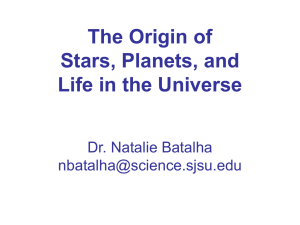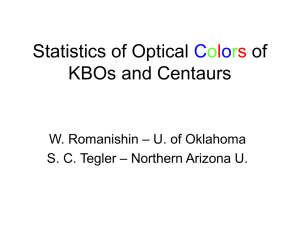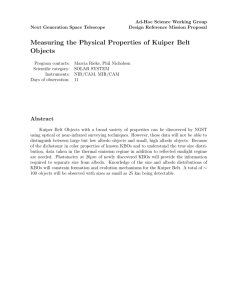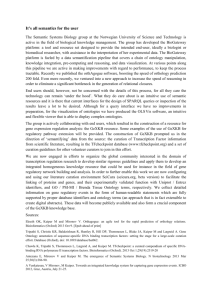lec17_07nov2011
advertisement
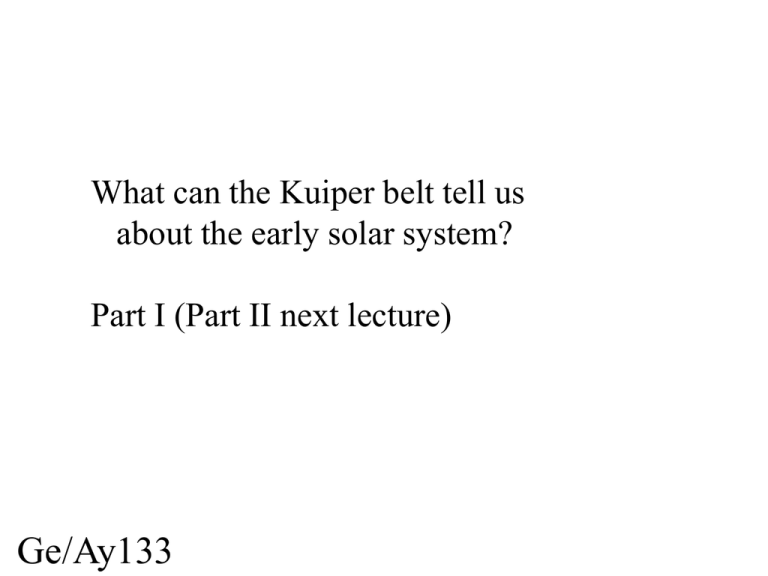
What can the Kuiper belt tell us about the early solar system? Part I (Part II next lecture) Ge/Ay133 Kuiper’s Hypothesis (1950) – Pluto should not be alone! 1999 KR 16 First (non-Pluto) trans-Neptunian object found in 1992 (Jewitt & Luu), now many many hundreds. They are found through their motion on the sky, gives R,i fairly quickly. What size range is inferred (constant albedo, etc.)? Where is the mass Concentrated? How might we probe the small size end of the distribution? One approach: The Taiwan-America Occultation Survey (TAOS) Zhang et al. 2008, ApJ, 685, L157 Sizes/Albedos? Only known for the largest objects: ERIS as seen by the HST 2002 AW197 as seen by the SST Would like measurements BEYOND the blackbody peak! Need ALMA/CCAT to go as deep as optical surveys. Can such telescopes search for large bodies very far from the Sun (flux goes as R-2, not R-4). What are large KBOs made of? Those with moons and measured sizes yield bulk densities consistent with ice/rock mixtures. The SURFACE composition is variable, but for large KBOs typically is dominated by volatiles (water, methane, carbon dioxide and the like). Does this reflect surface/atmosphere interactions? Volatile retention over solar system history? Population expected from primordial disk: Why? Disk observations & theory on the one hand, and … Wide Kuiper Belt binaries on the other: Formation time of wide binaries at current Kuiper Belt density is extremely long; & harkens to an earlier epoch with much higher mass surface densities and low collisional velocities. Likely primordial. 1998 WW31 Small moons that orbit big objects likely collisional (more later). 2003 EL61 Population expected from primordial disk: What is observed? Uranus crossing Neptune crossing Plutinos 3:2 ? 2:1 scattered KBOs classical KBOs Plutinos 3:2 2:1 scattered KBOs classical KBOs scattered inclination plutinos Dyamical definitions of various KBOs: classical semi-major axis (AU) Mike argues for two inclination distributions. Any differences? Only color, so far. Does this imply that their origin or composition must be different also? Trujillo and Brown, 2002 Is there a sharp edge to the Kuiper belt, and if so the solar system or original disk? S J U N P Pluto Mars Saturn Neptune ? Venus Kuiper belt Pluto Mars Saturn Neptune ? Venus Pluto Quaoar Neptune J Uranus # discovered KBOs Observed KBO radial distribution S Inferred KBO radial distribution Pluto Quaoar Neptune S Uranus J number 0 50 100 heliocentric distance number r-3/2 0 50 100 heliocentric distance number r-11 0 50 100 heliocentric distance number Resume ~r-3/2 surface density distribution @100 AU 0 50 100 heliocentric distance Kuiper belt Pluto Mars Saturn Neptune ? Venus Kuiper belt Pluto Venus The edge of the solar system Neptune Saturn Mars > What processes shaped the current Kuiper belt? Neptune migration? S J Should move out in a planetesimal swarm (why?)… U N P Need Jupiter! External Sculpting: Photoevaporation a la Proplyds? Orion Proplyd External Sculpting #2: Stellar encounter? (also a way to truncate the gas disk) Ida et al. 2000 35 deg Need to see more distant objects! Ida et al. 2000 e i Internal Sculpting: Effect of a large scattered planetesimal? (Miso~r3/4, nearly 7 Mearth at 40 AU) a Petit et al. 1999 From whence the Plutinos? S J If Neptune’s migration is sufficiently `slow’, KBOs can be trapped into orbital resonances that move outward w/planet. Hard to explain i distribution of `classical’ belt this way.
